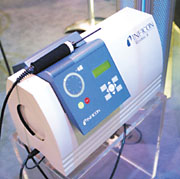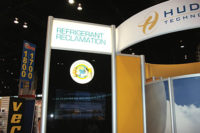

There was certain pragmatism to the choice. Europe faces a much faster phaseout of R-22 than the United States, so manufacturers had to move quickly than their American counterparts. R-407C operates similarly to R-22, so equipment did not have to undergo a major redesign.
But while unit manufacturers dip toward 407C, the major refrigerant manufacturers are taking a neutral position as to what refrigerant will eventually dominate the air conditioning sector.
DuPont showed literature on both refrigerants and noted their availability.
Honeywell made note of its R-410A product AZ-20 as a long-term alternative to R-22. AZ-20 was long promoted by Allied-Signal, which has since been absorbed into Honeywell.
The French company Solvay stayed neutral in the refrigerant-of-choice debate by noting a full range of fluorocompounds.
Refrigerant Products Ltd. of England promoted a product called RS-24, a blend of 134a, 125, and an HC called petane. Booth officials said the percentage of mixture was proprietary, but that efforts would be made to secure a SNAP listing from the U.S. EPA so the product can be sold in the United States. It was billed as a zero-ODP drop-in replacement for R-22, requiring no oil change.
Rhodia of England focused on a refrigerant it called Isceon 55, which it said is an HFC that has been assigned an ASHRAE number of R-417A and a safety classification of A1/A1. The company claims the blend of 125/134a/600 can be used with both mineral and ester oils, and can replace R-22.
Refrigerants consisting of pure isobutane, ethane, propylene, and propane, as well as other mixtures, were packaged by Calor of England.

RECOVERY UNITS
Recovery requirements in Europe have finally caught up to those in the United States, and that meant more attention than ever was paid to recovery/recycling equipment.Receiving its world premiere at the show was the MiniMax from Amprobe. It uses the same pump as the familiar Promax recovery units, but was said to be smaller and lighter.
Ritchie Engineering’s focus was on the Recover X, said to recover all refrigerants including R-410A. For CPS, attention was on its Pro-Set oilless units.
FluoroTech boasted of a faster recovery unit for all refrigerants including R-410A. It billed its new unit as having a “new, proprietary high-performance compressor.” One of its products was called Stinger Model 2000, said to be smaller and lighter than any other on the market.
Speed was also the sales pitch of the Reftec unit, in which the intake chamber automatically flashes and vaporizes incoming refrigerant to ensure that the liquid does not damage the compressor head.

BEYOND HFCs
The fuss over phasing out HFCs appears to have diminished somewhat in Europe, although efforts to work with HCs and other possible refrigerants continue. One project from TNO Environment of the Netherlands involved a ground-source heat exchanger using CO2.BOC Gases from the United Kingdom made its debut at the show with an array of refrigerants including HCFCs, HFCs, ammonia, HCs, liquid nitrogen, and CO2. York also showed technology employing CO2 in industrial refrigeration applications. And Danfoss showed a fan-cooled condensing unit that works with propane.
For halocarbon systems, Hansen Technologies showed an auto-purger that is said to reduce condensing pressure to save energy.
For manufacturers in need of a vacuum and filling unit, E.T.S. Elettronica offered a computerized unit said to prevent the need for recalibration.
RELATED COMPONENTS
The Italian company Wigam put a charging scale, manifold gauge set, and a pump on a small, low-level cart on wheels to assist in servicing.An electronic manifold from Fuji Electric was billed as the first to measure pressure, vacuum, and temperature.
Leak detection is drawing increased concern in Europe. Inficon of Germany showed a testing procedure used on assembly lines. After the subassembly of a refrigeration product, the unit is helium charged and tested with an Inficon detector. The helium is then recovered; the product goes through a final assembly and is charged with refrigerant. Then there is a final assembly leak test.
Publication date: 11/13/2000





